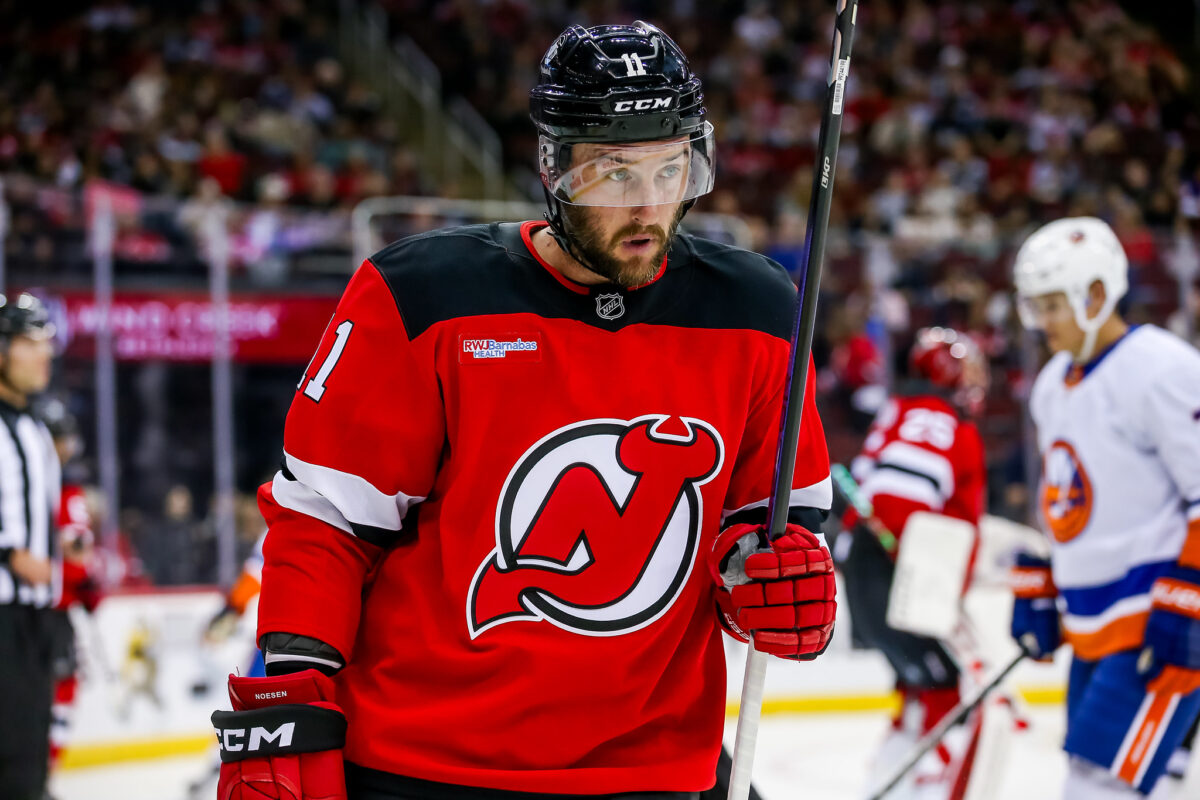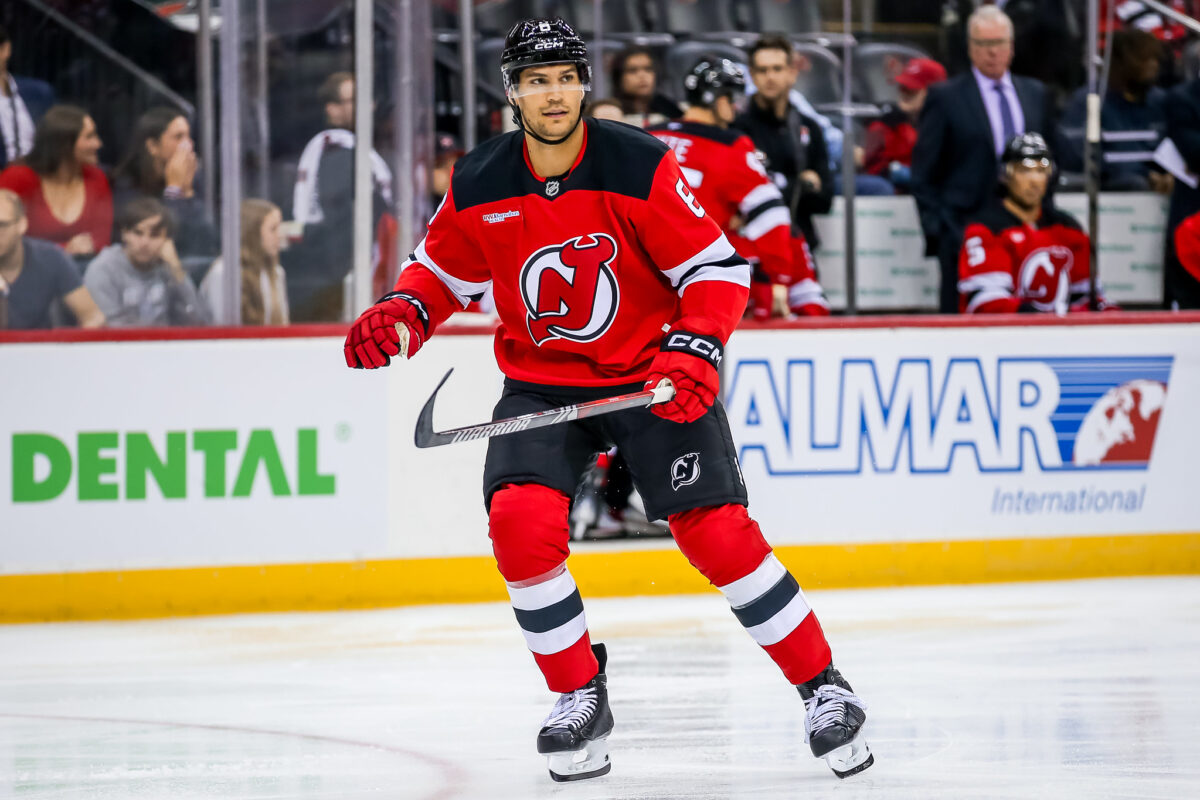When was the last time the New Jersey Devils dominated a team without a goal from Jack Hughes, Timo Meier, or Jesper Bratt? If game one demonstrated anything other than that general manager Tom Fitzgerald was wise in choosing a coach who would mold his system to his players’ strengths, it is that when the Devils get consistent secondary scoring, they are challenging to beat. Last season, the team failed to get consistent secondary scoring from the forward group and ended the season 22nd in terms of the percentage of goals scored by defensemen.
Related: 25 Metropolitan Division Predictions for 2024-25
Every player in the top 12 forwards this season can hit double-digit goals. Everyone in the top nine has had a 20-goal season, and most have had 30-goal seasons. Scoring should not be a problem, and the best way to weather injuries to the top guys is for players lower in the lineup to put up points. As they showed in game one on Friday (Oct. 4), the talent is there to beat teams decisively when the Devils don’t get goals from Hughes, Bratt, and/or Meier.
New Style Will Lead to Opportunity
It has been clear since the first period of the first preseason game that this is not the same team as last season. While much of the personnel has returned, they are playing a relentless, three-zone, high-pressure system predicated on forcing turnovers and counterattacking with speed. With all four lines getting comfortable playing below the opponent’s goal line and using size and speed to create turnovers in the offensive zone, the Devils should have plenty of opportunity for quick and dirty goals off of turnovers around the net. Each of the first three goals of the Devils’ season was started with offensive zone pressure.

The new style of play eliminates the need to rely only on rush offense and one-on-one play, making the opportunity to score much more democratic. If they can continue to roll four lines that exert pressure, then high-danger scoring chances should spread throughout the lineup more liberally rather than stick to the top six.
The key to this success is the tone-setting play of the third line, which features Stefan Noesen, Erik Haula, and Ondrej Palat. The trio of grinders has over 1,800 games of experience heading into the season. As a group, they had over 900 points at that time and should have been able to provide the secondary scoring New Jersey needs.
Likewise, the fourth line should be able to provide some offensive support. With Curtis Lazar anchoring Nathan Bastian and Paul Cotter, the line will boast a heavy forecheck and more speed than almost any other fourth line in the NHL. The fourth goal on Friday demonstrated how the line’s tenacity, speed, and skill will directly translate into goals. Bastian was disruptive in the defensive zone, stole a puck, and flipped it out of the zone to Cotter, who settled it in the air and walked in to deposit it in the empty net.
Cotter has impressed in camp and the preseason. When they acquired him in the trade for Akira Schmid, Fitzgerald indicated that the Devils believed he had a higher ceiling than a fourth liner. Cotter has flashed stickhandling skills and a quick and accurate shot, which makes him a dangerous player for New Jersey. With Cotter on the ice in the season’s opening game, the Devils had an expected goals for percentage of over 70; they also did not give up a high-danger chance while notching two of their own. All are good signs that Cotter’s presence will lead to more offensive opportunities for New Jersey to expand the goal distribution.
Lighting the Lamp From the Blue Line
Another way to survive injuries and scoring droughts from your stars is to get points from defensemen. Last season, with Dougie Hamilton hurt, none of the remaining defensemen, other than Luke Hughes, could find the scoresheet consistently. That changed immediately in game one, with Jonathan Kovacevic getting on the board with two points. The Devils have upgraded their defense corps to the point where they should be able to accrue points from all three pairs.

Players like Brenden Dillon, Jonas Siegenthaler, Kovacevic, and Brett Pesce are not on the team primarily for their offense, but each has a track record of being able to contribute. Dillon showed off his shot in the first game of the preseason and was involved in Nico Hischier’s goal on Friday. With Hamilton, Hughes, Simon Nemec, and even Seamus Casey, the remainder of the defense will not be called on to score much. Still, the group can stretch out the scoring, which is vital across a long regular season and into the playoffs should New Jersey want to make a deep run.
The Devils have been constructed with an eye on having many avenues for secondary scoring. In their first game against the Buffalo Sabres, they demonstrated how valuable that depth can be, winning a lopsided game with no point contributions from either one of the Hughes brothers, Hamilton, Meier, or Bratt. Should this continue, it bodes well for the Devils’ season.
